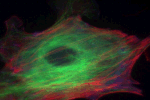Nanosurgery with femtosecond lasers
Subcellular surgery and nanosurgery,
at
Physics Colloquium, Amherst College (Amherst, MA),
Thursday, October 4, 2007:
Subcellular surgery and nanosurgery,
at
Physics Colloquium, University of Notre Dame (Notre Dame, IN),
Wednesday, May 12, 2010:
Sub-cellular nanosurgery in live cells using ultrashort laser pulses,
at
Photonics West (San Jose, CA),
Friday, January 21, 2005:
Using short bursts of photons to manipulate biological matter at the nanoscale,
at
Winter Colloquium on the Physics of Quantum Electronics (Snowbird, UT),
Friday, January 5, 2007:
Subcellular surgery and nanosurgery,
at
Physics Colloquium, Australian National University (Canberra, Australia),
Tuesday, March 24, 2009:
Plasmonic cell transfection using micropyramids,
at
SPIE Photonics West 2014 (San Francisco, CA),
Sunday, February 2, 2014:
Photodisruption in turbid tissue with 100-fs and 200-ps laser pulses,
at
APS Centennial Meeting 1999 (Atlanta, GA),
Friday, March 26, 1999:
Single neuron dissection in C. elegans by femtosecond laser pulses,
at
Photonics West 2006 (San Jose, CA),
Saturday, January 21, 2006:
Subcellular surgery and nanosurgery,
at
Physics Colloquium, University of Kentucky (Lexington, KY),
Thursday, October 25, 2007:
Determining properties of spindle microtubules with femtosecond nanosurgery,
at
BiOS 7897, SPIE Photonics West (San Francisco, CA),
Monday, January 24, 2011
Nanosurgery in live cells using ultrashort laser pulses,
at
2005 SPIE Photonics West Conference (San Jose, CA),
Tuesday, January 25, 2005:
Probing cell mechanics with femtosecond laser pulses,
at
Photonics West 2007 (San Jose, CA),
Sunday, January 21, 2007:
Manipulating cells using ultrashort laser pulses,
at
Wednesday Night Research Seminar, Harvard University (Cambridge, MA),
Wednesday, September 9, 2009:
Subcellular surgery and nanosurgery,
at
Western Washington University (Bellingham, WA),
Tuesday, May 13, 2014:
Photodisruption in biological samples using femtosecond laser pulses,
at
Photonic West Conference (San Jose, CA),
Tuesday, January 23, 2001:
 The detailed architecture of spindle microtubules, involved in cell division, was revealed using femtosecond laser nanosurgery. This work was performed in collaboration with the Needleman group (results published in Cell).
The detailed architecture of spindle microtubules, involved in cell division, was revealed using femtosecond laser nanosurgery. This work was performed in collaboration with the Needleman group (results published in Cell).